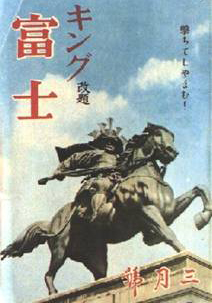 Cover page of the 1943 edition Cover page of the 1943 edition | |
| Categories | General interest |
|---|---|
| Frequency | Monthly |
| Founder | Seiji Noma |
| Founded | December 1924 |
| First issue | January 1925 |
| Final issue | 1957 |
| Company | Kodansha |
| Country | Japan |
| Based in | Tokyo |
| Language | Japanese |
| OCLC | 835840343 |
Kingu (キング, King) was a monthly general interest and entertainment magazine published in Tokyo, Japan, which existed between December 1924 and January 1957. It was the first popular best-selling Japanese magazine. It was also one of two most significant magazines in mid-twentieth century Japan, the other one being Ie no Hikari.
History and profile
Kingu was established in December 1924. The first issue appeared in January 1925. It was the eighth magazine launched by Seiji Noma, the founder of the publishing company Kodansha. It was modeled on Saturday Evening Post and Ladies' Home Journal. The magazine was published by Kodansha on a monthly basis.
Kingu covered moralistic stories and featured articles about samurai heroics, sentimental romance and melodramatic events. The magazine was read by urban and rural men and women. Major contributors included Yoshikawa Eiji, Kikuchi Kan, Maki Itsuma, Funabashi Seiichi, Tateno Nobuyuki, and Tsunoda Kikuo. It ended publication in 1957.
Circulation
Both Kingu and Ie no Hikari were the first Japanese million-seller magazines. Kingu sold one million copies in its first year, 1925. In 1928 the monthly circulation of the magazine was nearly 300,000 copies. The same year its total circulation was 1.4 million copies. Kingu sold more than a million copies again in 1927.
Legacy
In 2019 Amy Bliss Marshall published a book named Magazines and the Making of Mass Culture in Japan in which she analyzed Kingu and Ie no Hikari to demonstrate the birth of mass culture in Japan. The author argues that these two magazines were instrumental in the establishment of mass culture and in the socialization in Japan.
The name of Kodansha's music subsidiary King Records was actually based from the magazine.
References
- Barbara Sato (2003). The New Japanese Woman: Modernity, Media, and Women in Interwar Japan. Durham, NC; London: Duke University Press. p. 190. ISBN 0-8223-3044-X.
- "Mass Culture in Interwar Japan". Dissertation Reviews. 11 February 2013. Archived from the original on 7 May 2016. Retrieved 17 September 2016.
- Kazumi Ishii (August 2005). "Josei: A Magazine for the 'New Woman'". Intersections: Gender, History and Culture in the Asian Context (11).
- ^ Catherine Yoonah Bae (2008). All the girl's a stage: Representations of femininity and adolescence in Japanese girls' magazines, 1930s–1960s (PhD thesis). Stanford University. p. 38. ISBN 978-0-549-62286-4. ProQuest 304468205.
- ^ Jung-Kim, Jennifer J. (2006). "Gender and Modernity in Colonial Korea". CSW Update Newsletter: 53. ISBN 978-0-549-71329-6.
- ^ "A Guide to Japanese References and Research Materials". University of Michigan. Retrieved 17 September 2016.
- ^ Roichi Okabe (1987). "American public address in Japan: A case study in the introduction of American oratory through the Yuben". In Richard J. Jensen; John C. Hammerback (eds.). In Search of Justice: The Indiana Tradition in Speech Communication. Amsterdam: Rodopi. p. 38. ISBN 90-6203-968-5.
- "Timeline of Modern Japan (1868-1945)". About Japan. Retrieved 17 September 2016.
- Louise Young (1999). Japan's Total Empire: Manchuria and the Culture of Wartime Imperialism. Berkeley and Los Angeles, CA; London: University of California Press. p. 72. ISBN 978-0-520-21934-2.
- Mary L. Hanneman (2013). Japan faces the World, 1925-1952. London; New York: Routledge. p. 29. ISBN 978-1-317-87895-7.
- Amy Bliss Marshall (October 2013). "Devouring Japan: Proposal" (PDF). University of Texas. Archived from the original (PDF) on 9 August 2016. Retrieved 17 September 2016.
- John Clark (2000). "Indices of modernity". In Elise K. Tipton; John Clark (eds.). Being Modern in Japan: Culture and Society from the 1910s to the 1930s. Honolulu: University of Hawaiʻi Press. p. 35. ISBN 978-0-8248-2360-3.
- Sandra Wilson (Summer 2011). "Enthroning Hirohito: Culture and Nation in 1920s Japan". Journal of Japanese Studies. 37 (2): 289–323. doi:10.1353/jjs.2011.0060. JSTOR 41337678. S2CID 145523341.
- Takiji Kobayashi (2013). The Crab Cannery Ship and Other Novels of Struggle. Honolulu: University of Hawaiʻi Press. p. 296. doi:10.1515/9780824837907. ISBN 9780824837907.
- ^ "Magazines and the Making of Mass Culture in Japan". University of Toronto Library. Archived from the original on 26 July 2020. Retrieved 26 July 2020.